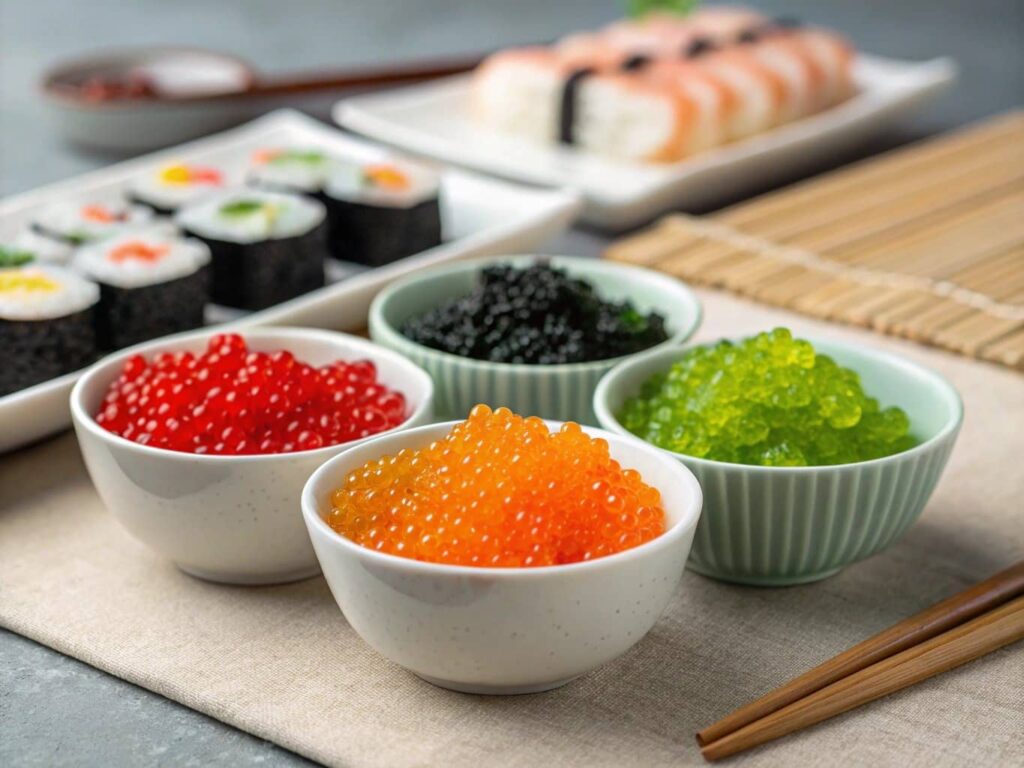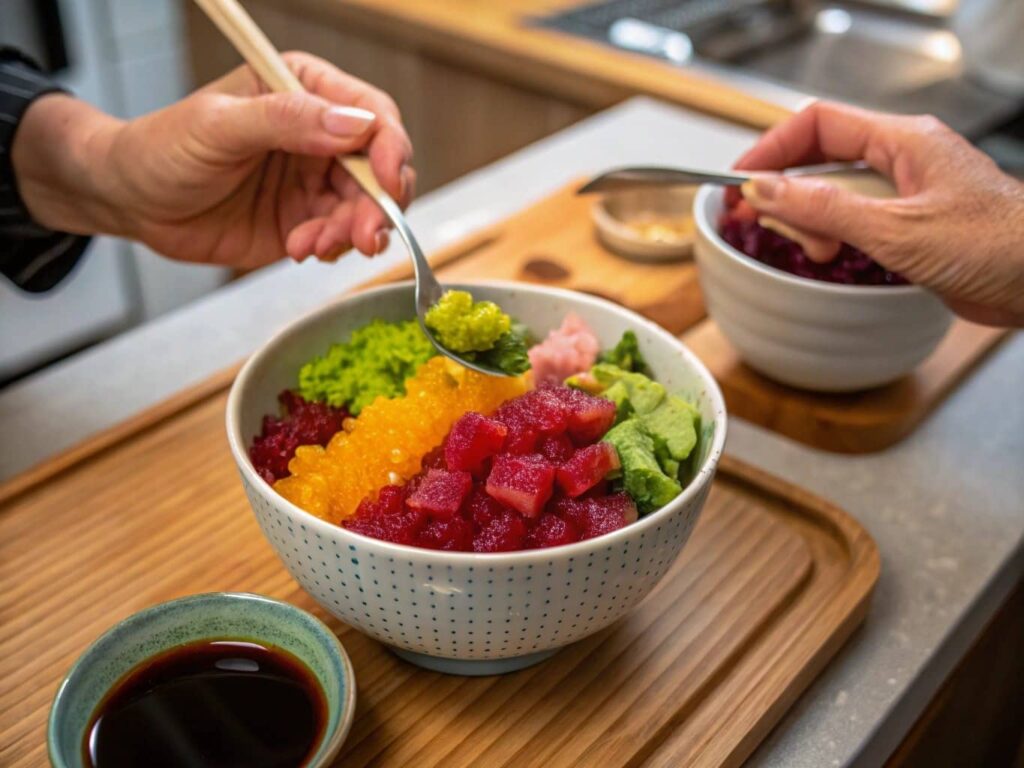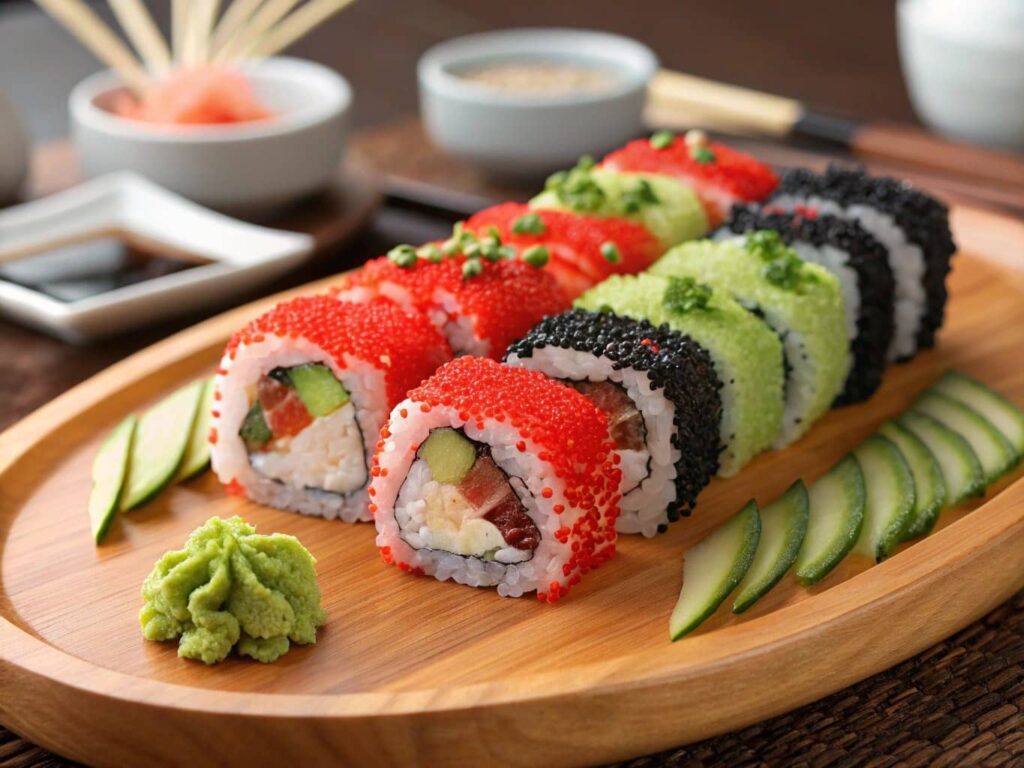What Is Tobiko? Tobiko might sound like a strange word if you’ve never heard it before, but it’s actually a delicious, colorful topping often found in sushi. So, if you’ve ever wondered, “Why is it so popular in sushi?” you’ve come to the right place. In this article, we’ll explore everything you need to know—what it is, where it comes from, its health benefits, and how it’s used in sushi. Ready? Let’s dive in!
Table of Contents
The Delightful Fish Roe
Imagine a tiny, crunchy, and colorful bead sprinkled on top of your sushi roll—well, that’s Tobiko! It’s fish roe, or the eggs of a fish, commonly used as a garnish in sushi. The word “Tobiko” comes from the Japanese language, where “tobi” means “fly” and “ko” means “child” or “egg.” So, in a way, it means “flying egg,” and it’s easy to see why—these little eggs are tiny and light, almost like they could take flight!
But it isn’t just about looking pretty. These tiny fish eggs have a unique flavor and texture that makes them a perfect addition to sushi. They’re crunchy, slightly salty, and have a subtle seafood taste that pairs beautifully with other ingredients like rice, fish, and vegetables.
Origins: Where Does It Come From?
Now that you know what Tobiko is, you might be wondering, “Where does it come from?” Great question! It comes from different species of fish, but the most common source for sushi is the roe of the flying fish. The flying fish gets its name from its ability to glide over the water’s surface, and its roe is harvested for this topping. While flying fish are the most common source, you can also find it made from other fish eggs, like salmon roe (Ikura), though they differ in flavor and appearance.
The History of This Ingredient in Sushi Culture
Believe it or not, What Is Tobiko? Tobiko didn’t become a popular sushi topping until around the 1970s. Sushi has been around for hundreds of years, but it wasn’t until more modern times that this fish roe started showing up as a garnish. Its bright colors and unique texture made it a hit, and it quickly became a beloved topping for sushi rolls, especially in Japan. Today, sushi restaurants worldwide widely use it, making it a must-have ingredient.
What is It Made Of? Understanding the Composition
So, what exactly makes it up? While it’s primarily fish roe, the preparation process adds a bit of flair to make it stand out. Most of it is orange, but it can also be red, black, green, or yellow. These colors come from natural ingredients like wasabi, squid ink, or beet juice.
Different Types of Tobiko: Fish Species and Varieties
What Is Tobiko? The most common type of Tobiko comes from flying fish, but different fish species and preparation methods create various types with unique colors and flavors. Let’s take a closer look at some popular varieties:

Red Tobiko
Red Tobiko is the most traditional and commonly seen in sushi. It has a bright red color and a mild, slightly sweet flavor. You’ll likely encounter it as a topping for sushi rolls, sprinkled over salads, or added to other sushi dishes.
Black Tobiko
Black Tobiko comes from a different fish, usually smelt roe. It has a darker color, often deep brown or black, and a more intense flavor than red Tobiko. It’s popular in gourmet sushi for its rich color and robust taste.
Green Tobiko
Green Tobiko adds a spicy kick to sushi. It’s typically flavored with wasabi, giving it a zesty, peppery taste that pairs well with raw fish and sushi rolls. The green color comes from wasabi or natural green food coloring.
Yellow Tobiko
Yellow Tobiko is a fun variation, often colored with natural ingredients like citrus zest or saffron. It has a tangy flavor that adds a refreshing twist to sushi, perfect for dishes needing a pop of color and flavor.
How Tobiko is Harvested and Processed
Harvesting Tobiko is interesting. Fishermen collect the roe by hand when the fish spawn. They wash and clean it to remove impurities, then flavor or dye it. This creates the colorful, flavorful topping we love. After processing, Tobiko gets packaged and sold for sushi rolls or snacks.
Nutritional Benefits of Tobiko
Now that we know what Tobiko is and how it’s made, you might be wondering, “Is it healthy?” Well, it certainly has some health benefits that make it a tasty and nutritious addition to your diet. Let’s break it down.
Is Tobiko Good for You? The Health Benefits Explained
Tobiko is full of essential nutrients like protein, omega-3 fatty acids, and vitamins that support your health. These nutrients help improve heart health, boost your immune system, and promote overall well-being. Plus, it’s low in calories, making it a great, light, yet nutritious topping for your sushi rolls.
Tobiko and Its Role in a Balanced Diet
Tobiko is rich in essential nutrients like protein, omega-3 fatty acids, and vitamins that support your health. These nutrients help boost heart health, strengthen your immune system, and promote overall well-being. Plus, it’s low in calories, making it a light and nutritious topping for sushi rolls.
Tobiko in Sushi: A Key Ingredient for Flavor and Texture
Now that you know what it is and why it’s good for you, let’s explore how it’s used in sushi. Tobiko plays a key role in the taste and texture of sushi, making it more than just a pretty topping—it’s essential for the perfect sushi experience.
How Tobiko Enhances the Taste of Sushi Rolls
One of the best things about Tobiko is its unique texture. What Is Tobiko? It’s the vibrant fish roe that adds both color and crunch to your sushi experience. When you bite into it, you get a crunch that contrasts perfectly with the soft rice and tender fish in your sushi roll. Its salty, slightly sweet seafood flavor complements the other ingredients without overpowering them. Whether sprinkled on a California roll or used as a garnish for sashimi, this magic ingredient elevates the flavor of your sushi.
The Different Ways To Use It in Sushi Dishes
Tobiko commonly tops sushi rolls. For example, you may find it inside sushi rolls, mixed with fillings like avocado or cucumber. It also garnishes rice bowls, poke bowls, or salads. In some dishes, it blends with sauces like mayonnaise or soy sauce to create unique, flavorful dressings. It’s versatile and adds an extra burst of flavor and texture to almost any sushi dish!
Common Problems with Tobiko and How to Avoid Them
As with any ingredient, What Is Tobiko? It’s a delicate fish roe that adds great flavor and texture to dishes, but there are a few challenges when it comes to using it. While it enhances your meals, there are a few things to keep in mind to ensure it’s always at its best. Let’s take a look at some common problems and how to avoid them.
Why Tobiko Can Be Expensive and How to Save Money
What Is Tobiko? One of the most common issues people face with this ingredient is the price. Since it’s made from fish roe, it can sometimes be on the pricier side. The cost also depends on the type of fish used and whether it’s a specialty product. For example, premium varieties, especially those with added colors or flavors, can increase the cost significantly.
But don’t worry! If you want to enjoy the flavor without spending too much, there are ways to save. First, try looking for stores or online shops that sell Tobiko in bulk or during sales. Sometimes, sushi restaurants offer discounts if you buy in larger quantities or as part of a sushi-making kit. You can also explore alternatives like imitation roe (made from seaweed or other plant-based ingredients) that mimic the taste and texture but are more affordable.
How to Store Fish Roe Properly to Maintain Freshness
Freshness is key when it comes to fish roe, and if you don’t store it correctly, it can spoil quickly. This can result in a loss of flavor and texture, which nobody wants when they’re adding it to a dish.
To keep it fresh, always store fish roe in the fridge and consume it within a few days of opening. It’s best to keep it in an airtight container to prevent air exposure, which can dry it out. For longer-term storage, you can freeze it, but be aware that freezing may slightly affect its texture. If you plan to freeze it, make sure to thaw it in the fridge before use.
How to Make Homemade Fish Roe and Sushi at Home
If you’re feeling adventurous and want to take your sushi-making skills to the next level, you can even make your own fish roe at home. While it’s not exactly the same as buying it from the store, making a homemade version can be a fun experiment and give you control over the flavors and colors. Here’s how to do it:
Easy Fish Roe Recipes You Can Try
Making your own version involves a few basic ingredients, including fish roe (you can find fresh or frozen roe in many grocery stores), flavorings like soy sauce, and natural colorants (e.g., wasabi for green, beet juice for red, or squid ink for black). Here’s a simple method to try:
- Start with fresh fish roe—make sure it’s cleaned and ready to go.
- In a bowl, mix soy sauce, sugar, and a few drops of the natural coloring agent of your choice.
- Gently toss the fish roe in the sauce mixture until it’s evenly coated.
- Let it sit for about 30 minutes to allow the flavors to meld together.
- Once done, you can use it in your homemade sushi rolls or as a topping for rice dishes!

This method is a basic approach, and you can get creative by adding other ingredients like lemon zest or spices. Homemade fish roe may not be exactly the same as store-bought varieties, but it’s a fun way to experiment with flavors.
Where to Buy: Finding the Best Quality
If you’d prefer to buy ready-made roe instead of making it yourself, finding the best quality is key to ensuring you get that perfect flavor and texture. Let’s talk about where to look for it and how to pick the freshest options.
Online vs. Local Stores: Where to Shop for Fresh Fish Roe
What Is Tobiko? When it comes to buying this vibrant fish roe, you have a couple of options. Many local grocery stores, especially those with Asian or international food sections, will carry it. If you’re lucky enough to have a nearby sushi restaurant or specialty food store, they might even sell fresh Tobiko directly. However, if you’re looking for a wider variety, including rare flavors and premium options, shopping online might be your best bet.
Websites dedicated to sushi supplies or seafood often offer a broader range of products, from standard varieties to more exotic options. When shopping online, be sure to check reviews and ensure that the store ships it in proper refrigeration packaging so that the product stays fresh during transit.
Tips for Identifying High-Quality Roe
Not all roe is created equal, so how do you know if you’re getting the best quality? Here are a few tips to help you identify top-notch fish roe:
- Color: High-quality roe should have a vibrant color. Whether it’s red, black, or another hue, the color should be rich and deep, not dull or faded.
- Texture: The eggs should be firm and slightly crunchy. Avoid any that are mushy or slimy, as they may be overripe or poorly stored.
- Smell: Fresh roe should have a clean, sea-like smell. A strong fishy odor indicates that it’s past its prime.
- Packaging: Check the packaging date. Roe doesn’t have a long shelf life, so make sure it’s been stored properly and isn’t nearing its expiration date.
Taking these factors into account will help you choose the best roe for your sushi and ensure that it tastes as fresh as possible.
Common Fish Roe Substitutes in Sushi Dishes
What happens if you can’t find fish roe or you’re looking for a substitute? Don’t worry, there are some great alternatives that can mimic the texture and flavor in sushi. These substitutes can be perfect when you’re in a pinch or just want to try something new!
What to Use If You Can’t Find Fish Roe
If you’re out of luck and can’t find fish roe at your local store, you can try some of these substitutes:
- Masago: This is similar to fish roe, but it’s smaller and often found in sushi rolls. It’s a great alternative with a slightly different flavor.
- Imitation Roe: Made from ingredients like seaweed, imitation roe closely mimics the texture and look of real fish roe but is usually more affordable.
- Caviar: If you’re looking for a more luxurious option, caviar (especially roe from sturgeon) can be a great substitute. It’s richer and has a more intense flavor.
While these alternatives may not taste exactly the same, they can still bring a delightful crunch and flavor to your sushi dishes.
Fun Facts You Didn’t Know
We’ve learned a lot about fish roe, but there are still a few fun facts you might not know! Here are some interesting tidbits that will surprise you:
Interesting Fish Roe Trivia for Sushi Lovers
- Did you know that fish roe is considered a delicacy in many cultures around the world? It’s not just popular in Japan—countries like Russia, the United States, and China also enjoy roe in various forms!
- In some cultures, fish roe is believed to bring good luck, especially when eaten at special occasions or celebrations.
- Fish roe is often used in gourmet dishes outside of sushi, such as in pasta sauces or as a topping for salads and other seafood dishes.
- The word “caviar” originally referred only to roe from sturgeon fish. Now, it’s used to describe roe from various fish species, including salmon and trout.
Why Tobiko is an Essential Part of Japanese Cuisine
What Is Tobiko? Fish roe, or Tobiko, may be small, but it packs a big punch when it comes to flavor, texture, and versatility in sushi. Whether you love it as a garnish or as the star of your sushi rolls, it’s clear that Tobiko plays an important role in Japanese cuisine. By understanding where it comes from, how it’s used, and how to make the most of it, you can appreciate this special ingredient even more. So next time you’re enjoying sushi, take a moment to savor the crunch and flavor of Tobiko—it’s a little gem that adds so much to the dish!
Recommanded:
- Interested in elevating your sushi game? Check out our article on how to use Tobiko to enhance your sushi experience—it’s a must-read for sushi lovers!
- Looking for healthy and flavorful dishes? You might enjoy learning about whether Filipino Sinigang is healthy and how this comforting dish can be a nutritious part of your diet.




